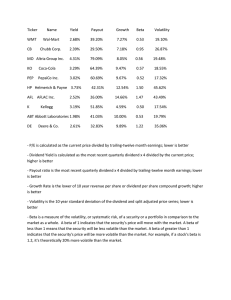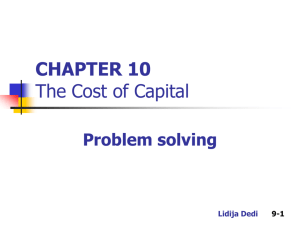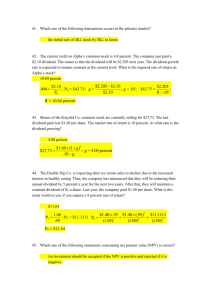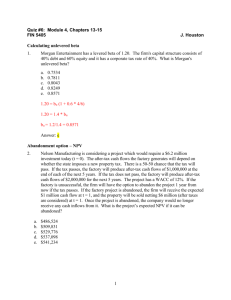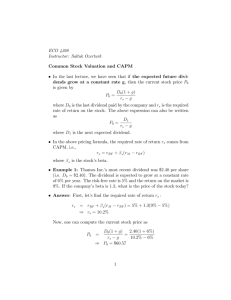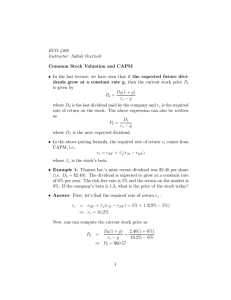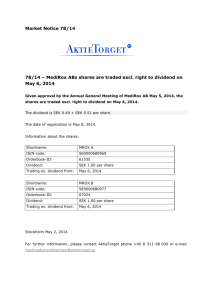Exam III: Review 2
advertisement
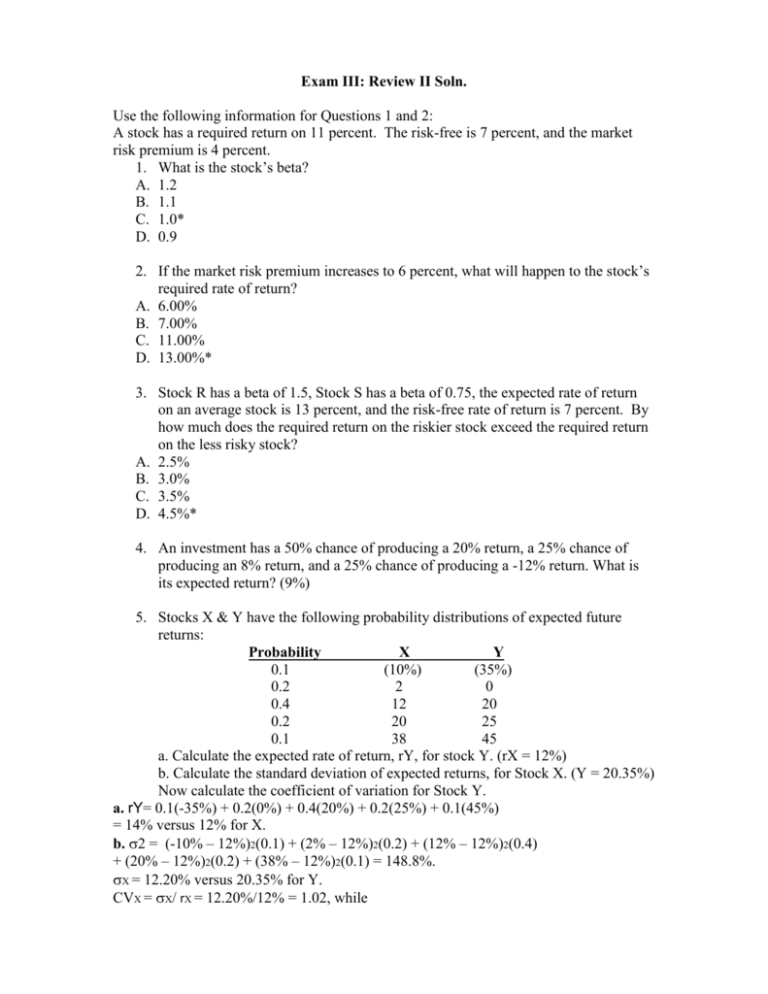
Exam III: Review II Soln. Use the following information for Questions 1 and 2: A stock has a required return on 11 percent. The risk-free is 7 percent, and the market risk premium is 4 percent. 1. What is the stock’s beta? A. 1.2 B. 1.1 C. 1.0* D. 0.9 2. If the market risk premium increases to 6 percent, what will happen to the stock’s required rate of return? A. 6.00% B. 7.00% C. 11.00% D. 13.00%* 3. Stock R has a beta of 1.5, Stock S has a beta of 0.75, the expected rate of return on an average stock is 13 percent, and the risk-free rate of return is 7 percent. By how much does the required return on the riskier stock exceed the required return on the less risky stock? A. 2.5% B. 3.0% C. 3.5% D. 4.5%* 4. An investment has a 50% chance of producing a 20% return, a 25% chance of producing an 8% return, and a 25% chance of producing a -12% return. What is its expected return? (9%) 5. Stocks X & Y have the following probability distributions of expected future returns: Probability X Y 0.1 (10%) (35%) 0.2 2 0 0.4 12 20 0.2 20 25 0.1 38 45 a. Calculate the expected rate of return, rY, for stock Y. (rX = 12%) b. Calculate the standard deviation of expected returns, for Stock X. (Y = 20.35%) Now calculate the coefficient of variation for Stock Y. a. rY= 0.1(-35%) + 0.2(0%) + 0.4(20%) + 0.2(25%) + 0.1(45%) = 14% versus 12% for X. b. = (-10% – 12%)2(0.1) + (2% – 12%)2(0.2) + (12% – 12%)2(0.4) + (20% – 12%)2(0.2) + (38% – 12%)2(0.1) = 148.8%. X = 12.20% versus 20.35% for Y. CVX = X/ rX = 12.20%/12% = 1.02, while CVY = 20.35%/14% = 1.45. 6. Suppose you are the money manager of a $4 million investment fund. The fund consists of 4 stocks with the following investments and betas: Stock Investment Beta A $400,000 1.50 B 600,000 (.50) C 1,000,000 1.25 D 2,000,000 0.75 If the market’s required rate of return is 14% and the risk-free rate is 6%, what is the funds required rate of return? Portfolio beta = [400,000/4,000,000](1.50) + [600,000/4,000,000] (-0.50) + [1,000,000/4,000,000] (1.25) + [2,000,000/4,000,000] (0.75) bp = (0.1)(1.5) + (0.15)(-0.50) + (0.25)(1.25) + (0.5)(0.75) = 0.15 – 0.075 + 0.3125 + 0.375 = 0.7625. rp = rRF + (rM – rRF)(bp) = 6% + (14% – 6%)(0.7625) = 12.1%. 7. Warr Corporation just paid a dividend of $1.50 a share (that is, D0 = $1.50). The dividend is expected to grow 7% a year for 3 years and then at 5% a year thereafter. What is the expected dividend per share for each of the next 5 years? D0 = $1.50; g1-3 = 7%; gn = 5%; D1 through D5 = ? D1 = D0(1 + g1) = $1.50(1.07) = $1.6050. D2 = D0(1 + g1)(1 + g2) = $1.50(1.07)2 = $1.7174. D3 = D0(1 + g1)(1 + g2)(1 + g3) = $1.50(1.07)3 = $1.8376. D4 = D0(1 + g1)(1 + g2)(1 + g3)(1 + gn) = $1.50(1.07)3(1.05) = $1.9294. D5 = D0(1 + g1)(1 + g2)(1 + g3)(1 + gn)2 = $1.50(1.07)3(1.05)2 = $2.0259. 8. Thomas Brothers is expected to pay $0.50 per share dividend at the end of the year (that is, D1 = $0.50). The dividend is expected to grow at a constant rate of 7% a year. The required rate of return on the stock, Rs, is 15%. What is the stock’s value per share? D1 = $0.50; g = 7%; rs = 15%; P(hat) 0 = ? 9. Harrison Clothiers’ stock currently sells for $20 a share. It just paid a dividend of $1.00 a share (that is, Do = $1.00). The dividend is expected to grow at a constant rate of 6% a year. What stock price is expected 1 year from now? What is the required rate of return? 12. Smith Technologies is expected to generate $150 million in free cash flow next year, and FCF is expected to grow at a constant rate of 5% per year indefinitely. Smith has no debt or preferred stock, and its WACC is 10%. If smith has 50 million shares of stock outstanding, what is the stock’s value per share? The firm’s free cash flow is expected to grow at a constant rate, hence we can apply a constant growth formula to determine the total value of the firm. Firm value = FCF1/(WACC – g) = $150,000,000/(0.10 – 0.05) = $3,000,000,000. To find the value of an equity claim upon the company (share of stock), we must subtract out the market value of debt and preferred stock. This firm happens to be entirely equity funded, and this step is unnecessary. Hence, to find the value of a share of stock, we divide equity value (or in this case, firm value) by the number of shares outstanding. Equity value per share = Equity value/Shares outstanding = $3,000,000,000/50,000,000 = $60. 13. Fee Founders has perpetual preferred stock outstanding that sells for $60 per share and pays a dividend of $5 at the end of each year. What is the required rate of return? 14. The real risk-free rate is 3 percent. Inflation is expected to be 3 percent this year, 4 percent next year, and then 3.5 percent thereafter. The maturity risk premium is estimated to be 0.05 X (t-1)%, where t = number of years to maturity. What is the yield on a 7-year Treasury note? r = r* + IP + MRP + DRP + LP. r* = 0.03. IP = [0.03 + 0.04 + (5)(0.035)]/7 = 0.035. MRP = 0.0005(6) = 0.003. DRP = 0. LP = 0. rT7 = 0.03 + 0.035 + 0.003 = 0.068 = 6.8%.


